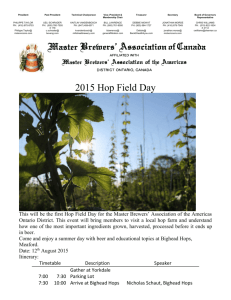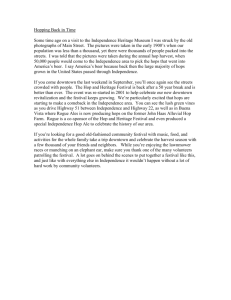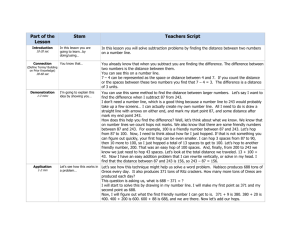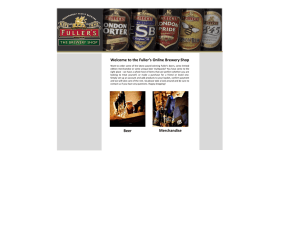Fundamentals of beer and hop chemistry
advertisement
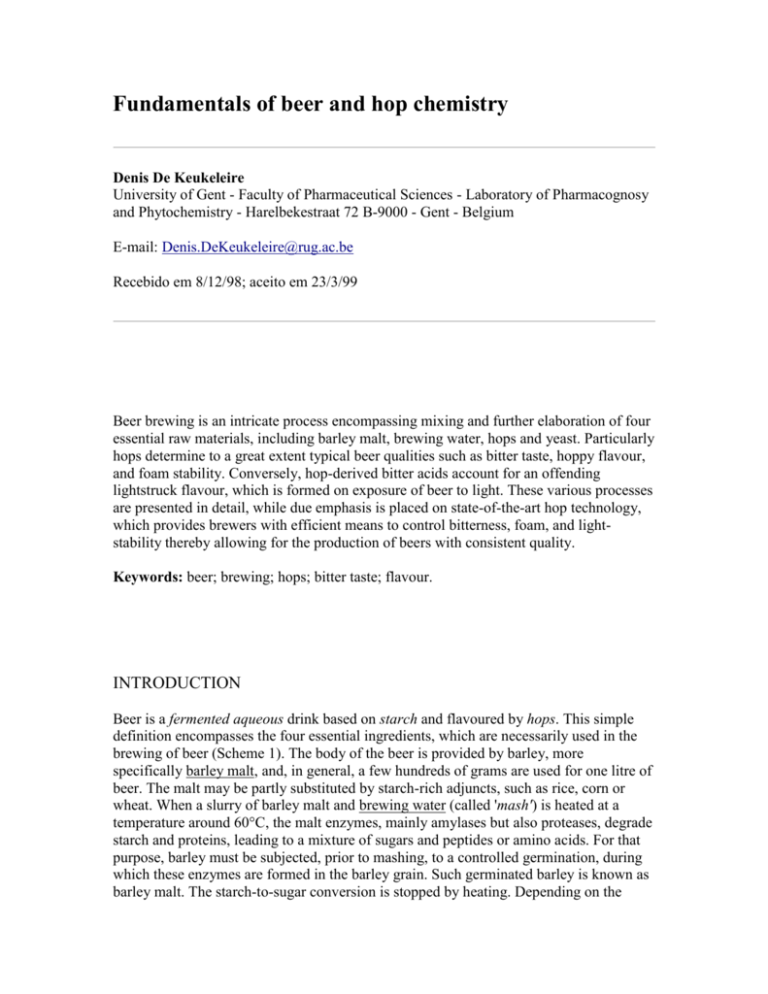
Fundamentals of beer and hop chemistry
Denis De Keukeleire
University of Gent - Faculty of Pharmaceutical Sciences - Laboratory of Pharmacognosy
and Phytochemistry - Harelbekestraat 72 B-9000 - Gent - Belgium
E-mail: Denis.DeKeukeleire@rug.ac.be
Recebido em 8/12/98; aceito em 23/3/99
Beer brewing is an intricate process encompassing mixing and further elaboration of four
essential raw materials, including barley malt, brewing water, hops and yeast. Particularly
hops determine to a great extent typical beer qualities such as bitter taste, hoppy flavour,
and foam stability. Conversely, hop-derived bitter acids account for an offending
lightstruck flavour, which is formed on exposure of beer to light. These various processes
are presented in detail, while due emphasis is placed on state-of-the-art hop technology,
which provides brewers with efficient means to control bitterness, foam, and lightstability thereby allowing for the production of beers with consistent quality.
Keywords: beer; brewing; hops; bitter taste; flavour.
INTRODUCTION
Beer is a fermented aqueous drink based on starch and flavoured by hops. This simple
definition encompasses the four essential ingredients, which are necessarily used in the
brewing of beer (Scheme 1). The body of the beer is provided by barley, more
specifically barley malt, and, in general, a few hundreds of grams are used for one litre of
beer. The malt may be partly substituted by starch-rich adjuncts, such as rice, corn or
wheat. When a slurry of barley malt and brewing water (called 'mash') is heated at a
temperature around 60°C, the malt enzymes, mainly amylases but also proteases, degrade
starch and proteins, leading to a mixture of sugars and peptides or amino acids. For that
purpose, barley must be subjected, prior to mashing, to a controlled germination, during
which these enzymes are formed in the barley grain. Such germinated barley is known as
barley malt. The starch-to-sugar conversion is stopped by heating. Depending on the
conditions (time, temperature), pale or amber-coloured or even dark malts are obtained,
the colour being due to caramelization of sugars and to Maillard-type reactions. It is
important to notice that the colour of beer is derived from the colour of the malt(s) used.
Furthermore, it is obvious that coloured malts exhibited a distinct taste, which often is
characteristic of particular dark beers.
After filtration, the sugar solution, in brewers' jargon called 'wort', is transferred to the
brewing kettle, where it is boiled during at least one hour with the addition of hops
(Humulus lupulus L.). The amount of hops needed is only a fraction of the substantial
quantities of malt used in the brewery. Usually, a few grams of hops are sufficient as a
quantitatively minor, but qualitatively major ingredient with crucial impact on welldefined beer features. Besides the formation of insoluble complexes with proteins and
polypeptides, contributing to the colloidal stability of beer, hops sterilize the wort
solution, which takes care of the bacteriological stability of beer. The most important
asset of hops is the bitter taste conferred to, particularly, blond beers. Furthermore, hops
are necessary for the stabilization of beer foam, while, on the other hand, the most
precarious off-flavour in beer, called lightstruck flavour, involves degradation of hopderived components (see below).
After cooling and removal of spent hops, the liquid, known as 'hopped wort' is pumped to
the fermentation vessels and yeast is added under aeration for growth. During the
anaerobic phase yeast cells convert sugars to ethanol and carbon dioxide. Depending on
the temperature during fermentation and the nature of yeast collection at the end of the
fermentation period, beers are distinguished as being produced by 'bottom fermentation'
or 'top fermentation'. Yeast strains, appropriate for bottom-fermented beers
(Saccharomyces carlsbergensis), are active below 5°C and they settle to the bottom of
the fermentor after production of about 5% ethanol. Conversely, yeasts, typical for the
production of top-fermented beers (Saccharomyces cerevisiae), operate at ambient
temperature and resist higher concentrations of ethanol, up to 12%. When the activity
stops, the yeast cells collect to the top as a dense foam.
A typical fermentation takes about one week thereby delivering a so-called 'green beer'
or 'young beer', which is not drinkable, as a number of offending (bad taste and smell)
compounds are formed during fermentation. Consequently, beers need a maturation or
lagering period of several weeks at about 0°C, during which the unwanted components
are slowly decomposed. High concentrations of diacetyl and pentane-2,3-dione are
particularly obnoxious for the quality of lager beers ('pilsner-type') and scrutinous
monitoring is required. Only after the content has decreased below critical values (ppbranges), beer can be packaged. For prolonged conservation beers may be pasteurized.
Special beers often require a slow (several months) second fermentation, usually in oak
kegs, to generate sour flavours.
COMPLEX HOP FLAVOUR CHEMISTRY
The tastes of varying beer types are derived from a judicious choice of raw materials.
Hops, in particular, account, in addition to the bitter taste, for a delicate hoppy flavour in
beer. Until now, this extremely valuable organoleptic feature has not been fully defined.
It is generally accepted that the hoppy aroma in beer is a complex of sensory impressions
resulting from many different volatile compounds at low concentrations, many of them
acting in synergism1. It appears that volatiles, contained in the hop oil (0.5-3% in hops),
and non-volatiles, present in the hop polyphenolic fraction (3-6%), contribute to a full
mouthfeel during beer tasting. However, the composition of these hop fractions is very
complex and their study has been hampered by the low and varying concentrations
normally found in beer. Thus, detailed insights are, at present, elusive.
Obviously, during the boiling of hops in wort many constituents are volatilized or
oxidized and the hop-derived constituents, present in beer, are to a large extent different
from the original molecules, present in hops. It should be interesting to trace the fate of
individual volatile hop constituents, particularly terpenes, such as myrcene,
caryophyllene, humulene and farnesene, during wort boiling, but the variability due to
differing conditions and beers preclude that general statements be made. An inevitable
conclusion is that the very intricate composition of the hop oils becomes even more
complex during wort boiling.
Many brewers try to conserve part of the original composition by adding precious hop
varieties ('aroma hops') near the end of the boiling period. This procedure, known as 'late
hopping', may be combined with 'dry hopping', a special technique involving addition of
hops to beer just before packaging. By doing so, some original hop constituents are
directly transferred to the aqueous matrix thereby imparting a discrete hoppy character to
the beer. The growing success of small brewers (microbreweries, brewpubs) suggests
increasing recognition of the opportunities that the use of hops presents, in particular for
developing various hop aromas and flavours.
Hops may contribute up to about one third of the total polyphenols in beer. Little doubt
now remains that, amongst the polyphenolics, the low-molecular-weight
proanthocyanidins determine the colloidal stability of beer. The net result of boiling is a
dramatic change in the already complex polyphenol composition of wort2. It seems to be
impossible to get a reasonable insight into the fate of the polyphenolic mixture. Part of
the complexity can undoubtedly be ascribed to the ready oxidation and the ease of
polymerization of many polyphenols.
Hop polyphenols are found as monomers, dimers, trimers, but also as more complex
forms associated with nitrogenous components. It is common practice to distinguish
between 'chill haze' and 'permanent haze'. The polyphenols combine slowly with proteins
to form chill haze when cooled, but which redissolves when warmed up. As the
polyphenols polymerize and grow larger, they become insoluble at room temperature to
form irreversible haze. The extent to which a beer requires stabilization depends on its
shelf-life and the storage conditions after packaging. It appears that hop polyphenols are a
group of substances with interesting effects on taste and taste stability of beers. Taking,
moreover, the pronounced 'natural' anti-oxidant character of particular polyphenols into
account, it is obvious that, in the future, more attention will be focussed on the various
roles of polyphenols in brewing.
THE CHEMISTRY OF THE BITTER BEER TASTE
Bitter profiles in beer are well understood, as only few precursors are present in hops,
thereby facilitating research of beer bitter components3,4. Perhaps the most important
class of hop compounds are the hop acids, which are distinguished as alpha-acids or
humulones (1) and beta-acids or lupulones (2) (Scheme 2). The two series comprise, in
fact, three constituents differing in the nature of the side chain, which is derived from the
hydrophobic amino acids, leucine, valine and isoleucine, for humulone (1a)/lupulone
(2a), cohumulone (1b)/colupulone (2b) and adhumulone (1c)/adlupulone (2c),
respectively. An intriguing feature of the hop acids is their exceptionally high content, up
to 25% or even more, of the dry weight of the hop cones. The relative proportions of the
individual constituents depend strongly on the hop variety and, for a given variety, on the
conditions of growing. The hop acids occur as pale-yellowish solids in the pure state, are
weak acids, exhibit very poor solubility in water and have almost no bitter taste.
The hop acids have pronounced bacteriostatic activity; they strongly inhibit the growth of
Gram-positive bacteria. This action has been attributed to the interference of the prenyl
group, characteristic of the side chains of the hop acids, with the function of the cell
plasma membrane. It appears that the more prenyl groups (three in the beta-acids) are
present, the stronger the bacteriostatic action is. This remarkable bio-activity is of
importance for killing micro-organisms during wort boiling, which ultimately leads to a
sterile beer.
Varying applications have been explored to exploit the bacteriostatic activity of the betaacids. A highly interesting use is in the sugar industry to control and reduce bacterial
activity during extraction of sugar beets5. By dosing the hop beta-acids periodically in
amounts of 10 g per ton of beet, the lactic acid content of raw juice was reduced to 400
ppm without influence on the fermentation. Investigations on the fate of the hop
compounds showed that residual values in sugar, molasses and pulp are undetectable or
uncritical. It appears that formalin, a widespread processing aid in the sugar industry,
could be advantageously replaced by hop beta-acids.
Otherwise, the beta-acids are very sensitive to oxidative decomposition and most
oxidation reaction products possess unpleasant organoleptic characteristics.
Notwithstanding the fact that the beta-acids may possibly protect beer against oxidation,
they are, in general, considered a negative factor in brewing and a number of brewers
select hop varieties, that are poor in beta-acids.
The major component of the mixture of alpha-acids is humulone (1a). While the relative
amounts of humulone (1a) and cohumulone (1b) are variety-dependent (20-50%),
adhumulone (1c) constitutes invariably ca. 15% of the mixture. Cohumulone has been
associated with a poor hop quality, although this issue is not proven unambiguously6.
Detailed analysis by HPLC (high performance liquid chromatography) - MS (mass
spectroscopy) reveals the presence of other related alpha-acids, albeit in very small
concentrations.
The transformations of the humulones during wort boiling have been studied in great
detail3. By far the most important chemical conversion overall during the brewing of beer
is the thermal isomerization of the alpha-acids or humulones (1) to the iso-alpha-acids or
isohumulones (3 + 4) via an acyloin-type ring contraction (Scheme 3). Each humulone
gives rise to two epimeric isohumulones, which are distinguished as cis-isohumulones (3)
and trans-isohumulones (4), depending on the spatial arrangement of the tertiary alcohol
function at C(4) and the prenyl side chain at C(5). The terms trans and cis indicate that
these groups point to opposite faces and to the same face of the five-membered ring,
respectively.
Thus, humulone (1a) is isomerized to cis-isohumulone (3a) and trans-isohumulone (4a).
Consequently, six major iso-alpha-acids (cis-isohumulone and trans-isohumulone, cisisocohumulone and trans-isocohumulone, cis-isoadhumulone and trans-isoadhumulone)
are present in beer resulting from the conversion of the three major alpha-acids,
humulone, cohumulone and adhumulone, respectively. Figure 1 represents a reversedphase HPLC separation of the six major isohumulones in a typical lager beer. The early
part of the chromatogram refers to an oxidized fraction and is representative of the
'freshness' of the iso-alpha-acids.
The ratio of the isohumulones depends on the reaction conditions. In the wort medium it
is normally 68:32 in favour of the cis-compounds. However, the cis-compounds are much
more stable (half-life >> 5 years) than the trans-isomers (half-life of ca. 1 year) during
the course of time. This affects, obviously, the cis:trans ratio and has significant
consequences with respect to taste and flavour stability. Thus, it appears interesting to
have the highest content of cis-isohumulones possible in the mixture of isohumulones.
The iso-alpha-acids are intensely bitter, almost equivalent to quinine, the reference
compound for comparisons of bitterness. The threshold value in water has been estimated
at 6 ppm. The iso-alpha-acids constitute the quantitatively most important fraction of
hops in beer and they account for the typical bitter beer taste. Their concentrations vary
widely, from 15 ppm in typical American lager beers to nearly 100 ppm in very bitter
English ales. The real taste, as perceived by beer consumers, is largely modified by
complexation with residual sugars, present in beers, and, thus, the bitterness is evaluated
as 'pleasant bitterness'.
There are conflicting views on the bittering power of the individual isohumulones,
mainly as a consequence of differences in purity of the compounds that have been used in
taste trials. Purification of iso-alpha-acids is particularly difficult and reported results
should be interpreted with great caution. The utilization of cohumulone (1b) is better than
that of the other alpha-acids due to the more polar character and the increased solubility
in water. The organoleptic features of the isocohumulones, however, are subject to some
suspicion, as they generate a more 'harsh' bitterness with respect to the other
isohumulones.
In addition to imparting bitter taste to beer, the iso-alpha-acids exhibit other interesting
features: they have tensioactive properties, thereby stabilizing the beer foam, and inhibit
the growth of Gram-positive bacteria, thus protecting beer against these micro-organisms.
On the other hand, lactic acid bacteria in beer are resistant to iso-alpha-acids.
THE LIGHTSTRUCK FLAVOUR OF BEER
It has been thought that iso-alpha-acids and phenolic compounds are key components
with regard to beer stability. Iso-alpha-acids are partly responsible for production of
ageing off-flavours, including stale and cardboard flavours7. Volatile aldehydes, such as
trans-non-2-enal, are formed during storage of bottled beer from various precursors,
including hop lipids. On the other hand, it has been known for quite some time that beer
decomposes on exposure to light, thereby generating an offending 'skunky' flavour. Thus,
beer must be stored, either in opaque cans, or in green or brown bottles, in order to
prevent light from being transmitted through the glass.
The cause for this phenomenon is the vulnerability of the iso-alpha-acids to light. The
resulting decomposition leads to formation of the so-called 'lightstruck flavour'. The
light-sensitive chromophore in the isohumulones is the acyloin group composed of the
tertiary alcohol function at C(4) and the carbonyl group of the side chain at C(4).
Activation of, for example, the isohumulones 3a and 4a with UV light causes bond
cleavage by a Norrish Type I reaction, leading to a ketyl-acyl radical pair. Subsequent
loss of carbon monoxide from the acyl radical and recombination of the resulting
fragment with a thiol radical furnish 3-methylbut-2-ene-1-thiol, also known as 'skunky
thiol' (5, Scheme 4), together with dehydrohumulinic acid (6a)8.
The mechanism for the formation of the lightstruck flavour was confirmed by the
unambiguous identification of 3-methylbut-2-ene-1-thiol in illuminated beers. The
flavour threshold of the thiol is so low that even concentrations of few ppb spoil
irreversibly the beer quality. The thiol is formed also on exposure to visible light or
sunlight. Since the iso-alpha-acids do not absorb in the visible region, the reaction is
photosensitized, in first instance by riboflavin (vitamin B2)9.
NOVEL HOP TECHNOLOGY TO CONTROL BITTERNESS, FOAM AND
LIGHT-STABILITY OF BEERS
The isomerization of alpha-acids to iso-alpha-acids during wort boiling suffers from low
yields, which are seldom higher than 30%. The transfer of the alpha-acids from the
vegetative hop material, the restricted solubility of the alpha-acids in the aqueous matrix
and the almost neutral wort (pH 5-5.5) are critical factors. A better utilization of hops is
effected when hop extracts are used (40-50%). Liquid or supercritical carbon dioxide is,
indeed, an excellent medium to extract both the hop acids and the hop oil from hops.
Thus, new technologies aimed at exploiting the full potential of hops and optimizing the
utilization of hops in the brewing of beer - on the basis of original findings in our
laboratory - are gaining considerable importance. Opportunities for the development of
more flavour-consistent beers and diversified beer types abound.
Hops are fractionated on an industrial scale to a variety of 'hop products', based on liquid
or supercritical carbon dioxide extracts4. While the polyphenols reside in the spent hops,
an extract, rich in hop acids, or an extract, rich in hop oil, may be obtained, depending on
the operating temperatures and pressures. The hop volatiles can be separated from the oilrich extract as 'hop essences'. Crude fractionation of the total hop oil provides a 'floral oil'
and a 'spicy oil', respectively. The hop alpha-acids are accessible from a hop-acids-rich
extract using selective, pH-controlled solvent extraction. The alpha-acids prevail then as
a concentrate, which can readily be isomerized to the iso-alpha-acids, the principal beer
bitter constituents. Isomerization may be carried out by heating solid salts of particular
metal ions, e.g. magnesium(II) humulates. Alternatively, irradiation of the alpha-acids in
the wavelength region of 350-366 nm (UV-A light) provokes a fully regio- and
stereoselective photorearrangement, thereby affording exclusively trans-isohumulones
(4)8. Yields are in both cases almost quantitative.
These isohumulones, thus produced off-line (i.e. not by brewers, but by hop processors),
are formulated as potassium salts in concentrated aqueous solution. Such advanced hop
products can be applied to add bitterness to beer or to adjust bitterness levels at any stage
during the brewing process. Best organoleptic results are obtained when the
isohumulones are added near the end of wort boiling, hence when they fully participate in
fermentation and lagering. It was found that introduction of isohumulones just before
packaging must be accompanied by addition of very small amounts of hop oil (ca. 1 ppm)
in order to make such 'advanced' beers indistinguishable from 'traditional' beers10. Yields
of isohumulones, thus applied, exceed 80%.
Further manipulation of the iso-alpha-acids is carried out with the principal aim to brew
foam- and light-stable beers. In practice, iso-alpha-acids are converted to reduced isoalpha-acids with quite interesting properties11. Three major types of reduced iso-alphaacids should be considered depending on the number of hydrogen atoms (dihydro,
tetrahydro, hexahydro) incorporated during reduction.
Sodium borohydride reduction of the carbonyl group in the side chain at C(4) of the
isohumulones gives rise to dihydro-isohumulones (also known as 'rho-isohumulones'),
which are perfectly light-stable, as the light-sensitive acyloin group has been converted to
a diol. Since formation of the secondary alcohol function is accompanied by creation of a
new chiral centre, two epimeric dihydro-iso-alpha-acids arise from each iso-alpha-acid,
e.g. compounds 7a and 8a from trans-isohumulone (4a) (Scheme 5). Consequently, a
mixture of twelve dihydro-iso-alpha-acids may result from reduction of the six major isoalpha-acids. However, dihydro-iso-alpha-acids products are usually less complex due to
the reaction conditions employed and the resulting selectivities. Substitution of iso-alphaacids by dihydro-iso-alpha-acids allows brewing of light-stable beers, which can be
bottled in clear glass.
Tetrahydro-iso-alpha-acids are obtained by hydrogenation of the double bonds in the side
chains of the iso-alpha-acids, e. g. trans-tetrahydro-isohumulone (9a) from transisohumulone (4a). Commercially available tetrahydro-iso-alpha-acids are produced as a
mixture of six tetrahydro-iso-alpha-acids. Via reversed phase HPLC analysis of a beer,
made from iso-alpha-acids, in conjunction with tetrahydro-iso-alpha-acids, the
composition of the bitter constituents can be revealed, as shown in Figure 2. Saturation of
the double bonds leads to diminished reactivity and enhanced hydrophobicity, which has
a pronounced foam-positive effect. Since the acyloin group is still present, photochemical
reactions may occur on light exposure, although the allyl radical, intervening in the
formation of 3-methylbut-2-ene-1-thiol (5), can no longer be formed. Hop products,
based on tetrahydro-iso-alpha-acids, have become very popular recently, particularly in
view of the pronounced propensity to stabilize beer foam (Scheme 6). Brewers take
advantage of this by adding few ppm of tetrahydro-iso-alpha-acids to create a creamy
head on a glass of beer.
Hexahydro-iso-alpha-acids are accessible by a combination of the aforementioned
processes, i.e. reduction of the side-chain carbonyl group and hydrogenation of the
double bonds in the iso-alpha-acids. Trans-isohumulone (4a) would afford transhexahydro-isohumulones 10a and 11a, while the mixture of hexahydro-iso-alpha-acids
could theoretically be composed of twelve isomers and homologues. Real samples of hop
products based on hexahydro-isohumulones are much simpler as observed on HPLC
separation.
CONCLUSIONS
Beer is an extremely complex drink and several hundreds of constituents have been
identified hitherto. Hops are vital to the organoleptic qualities of beer, including taste and
flavour. During the multi-stage brewing process many hop components are modified, but
even the use of sophisticated separation and analysis techniques has, until now, not
allowed to identify unambiguous relations between particular hop-derived compounds
and sensory characteristics.
As opposed to the intricate chemistry of hop oils and hop polyphenols, the bitter taste
features of beer have been adequately profiled. Alpha-acids or humulones are converted
during wort boiling to iso-alpha-acids or isohumulones, which impart the typical bitter
taste to beer. Modern hop technology has unlocked the full potential of hops by providing
novel hop products, which allow brewers to adjust desired beer properties. Moreover, offflavours, such as the lightstruck flavour, can be obviated by bittering beers with advanced
hop products, based on reduced iso-alpha-acids or reduced isohumulones, thereby
rendering beers light-stable.
Both bottom- and top-fermented beers, using advanced hop products, have been made in
our pilot brewing facilities and sensory analysis proved their superior quality with respect
to more traditional brews. Judicious application of advanced analytical methods has been
essential to the successful penetration of new hop technologies into the beer world. Stateof-the-art analyses involving high-efficient chromatographic variants (e.g. reversed phase
HPLC)12 and electro-driven separation methods (e.g. CZE)13 have superseded classical
unspecific protocols. Validated quantification of various hop-derived compounds must
support beer quality control from a modern brewing perspective.
REFERENCES
1. Moir, M.; Hop Aromatic Compounds. In European Brewery Convention Monograph
XXII - EBC-Symposium on Hops, Zoeterwoude, The Netherlands, May/June 1994, Verlag
Hans Carl, Nuremberg, Germany, 1994, pp. 165-180.
2. Forster, A.; Beck, B; Schmidt, R.; Untersuchungen zu Hopfenpolyphenolen. In
European Brewery Convention, Proc. 25th Congr., Brussels, 1995, Oxford University
Press, Oxford, England, 1995, pp. 143-150.
3. Verzele, M.; De Keukeleire, D.; Chemistry and Analysis of Hop and Beer Bitter Acids,
Elsevier, Amsterdam, The Netherlands, 1991.
4. Benitez, J. L.; Forster, A.; De Keukeleire, D.; Moir, M. Sharpe, F. R.; Verhagen, L. C.;
Westwood, K. T.; Hops and Hop Products, Verlag Hans Carl, Nuremberg, Germany,
1997.
5. Pollach, G.; Hein, W.; Hollaus, F.; Zuckerind. 1996, 121, 919 - Hein, W.; Pollach, G.;
Zuckerind. 1997, 122, 940.
6. Meilgaard, M.; J. Inst. Brew. 1960, 66, 35.
7. Kamimura, M.; Kaneda, H.; Off-flavors in Beer. In Off-flavors in Foods and
Beverages, Ed. Charalambous, G., Elsevier, Amsterdam, The Netherlands, 1992, pp. 433472.
8. De Keukeleire, D.; Blondeel, G. M. A.; Tetrahedron Lett. 1979, 1343.
9. De Keukeleire, D.; Heyerick A.; University of Gent, unpublished results, 1998.
10. De Cooman, L.; Overmeire, H.; Aerts, G.; De Keukeleire, D.; University of Gent,
1998, unpublished results.
11. Goldstein, H.; Ting, P.; Post Kettle Bittering Compounds: Analysis, Taste, Foam and
Light Stability. In European Brewery Convention Monograph XXII - EBC-Symposium on
Hops, Zoeterwoude, The Netherlands, May/June 1994, Verlag Hans Carl, Nuremberg,
Germany, 1994, pp. 154-162.
12. De Cooman, L.; Everaert, E.; De Keukeleire, D.; Phytochem. Anal. 1998, 8, 1.
13. De Keukeleire, D.; David, F.; Haghebaert, K.; Sandra, P.; J. Inst. Brew. 1998, 104,
75.
